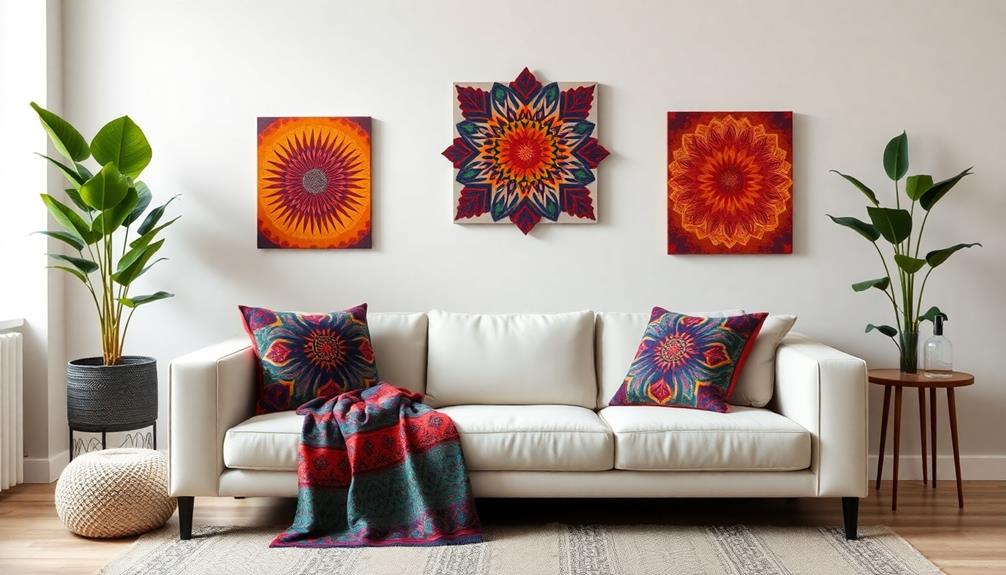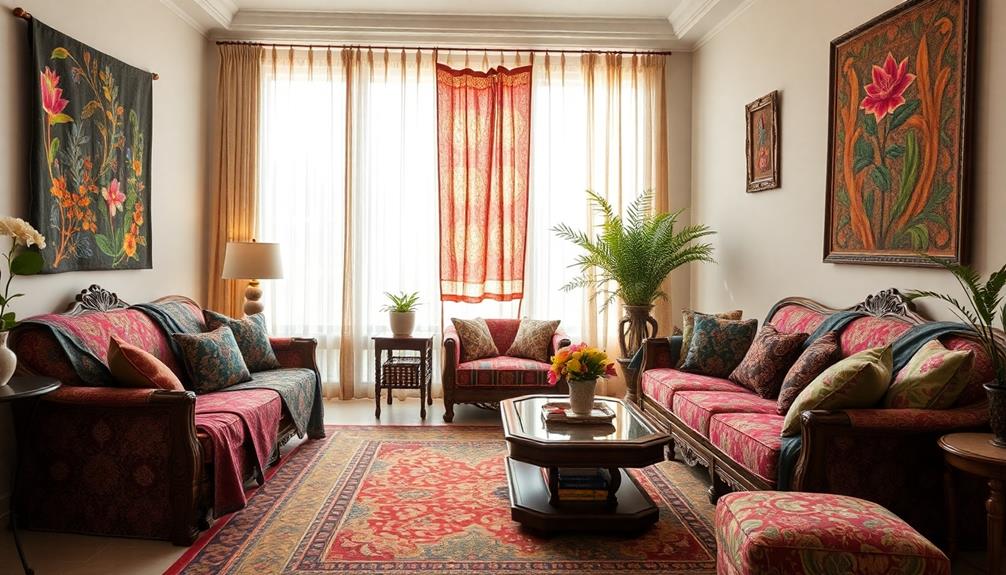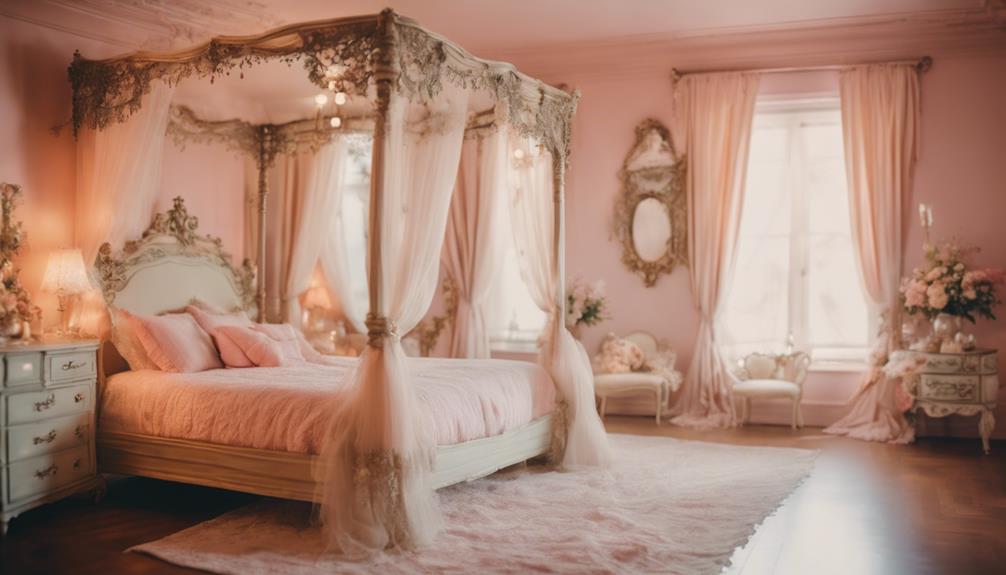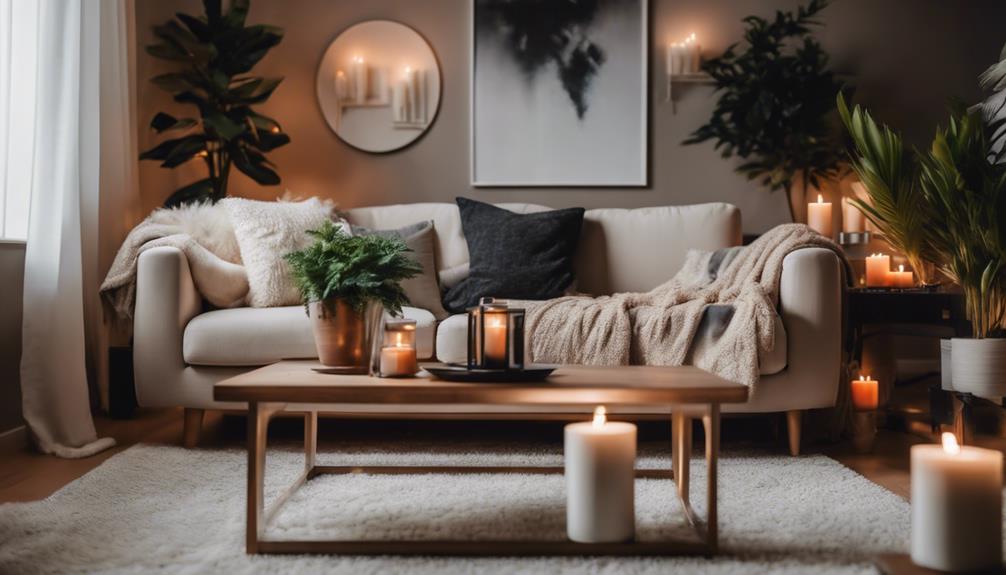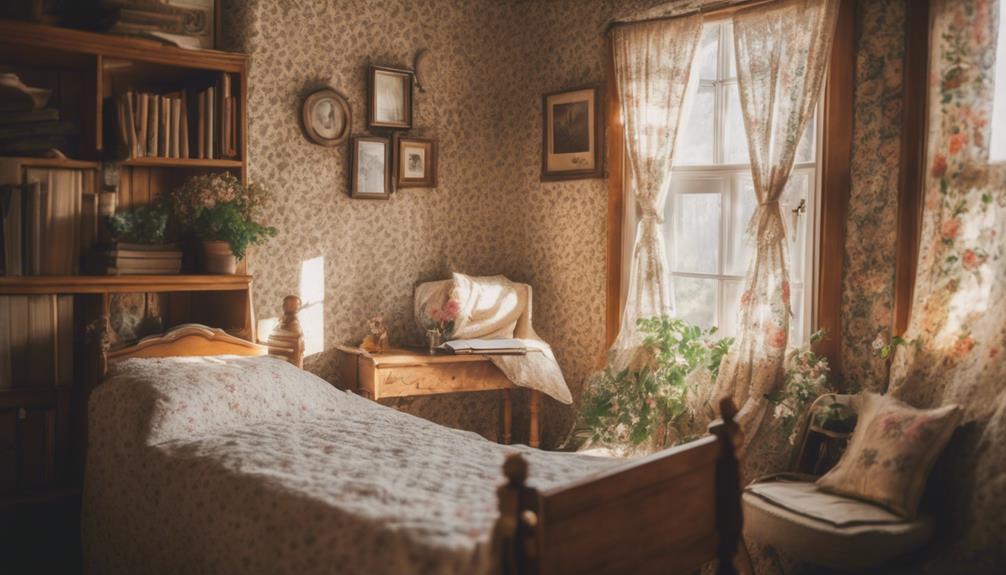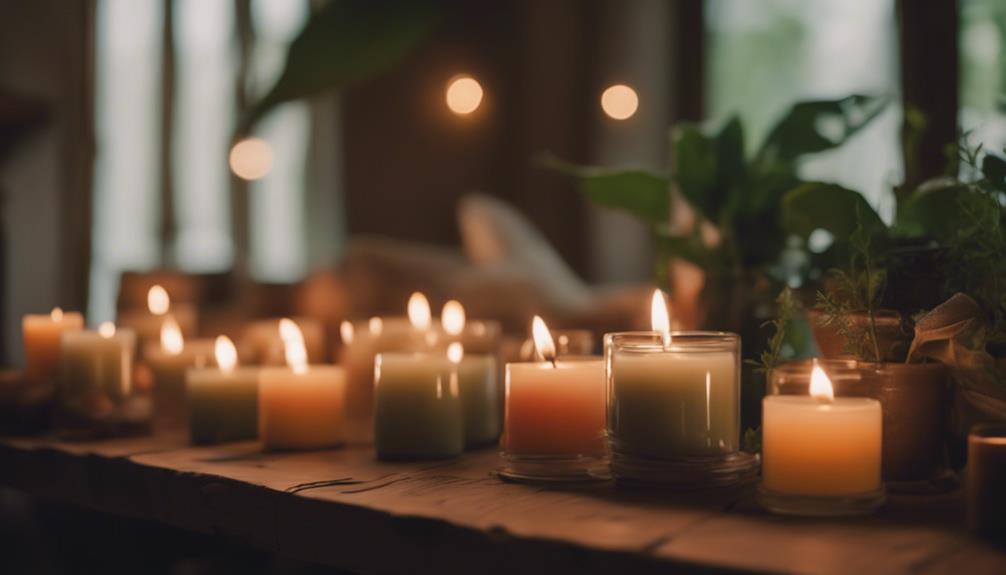You can effortlessly blend batik patterns into your home for a modern yet timeless look. Start by using large batik tapestries as wall art to create striking focal points. Consider incorporating accent pillows or throws with bold designs on your sofa for a pop of color and texture. Batik table runners and bed linens work wonderfully to add cultural elegance. Don't shy away from mixing traditional patterns with contemporary pieces; this juxtaposition enriches your decor. With a little creativity, batik can enhance any style, creating a space that feels both fresh and deeply rooted in heritage. There's so much more to explore!
Key Takeaways
- Incorporate batik accent pillows to add vibrant color and texture, enhancing modern furniture while maintaining a timeless appeal.
- Use batik tapestries as wall art to create a striking focal point, blending traditional patterns with contemporary decor styles.
- Opt for batik upholstery on chairs or sofas to introduce cultural heritage, seamlessly integrating with minimalist or rustic designs.
- Layer batik table runners or linens for dining areas, offering a unique blend of elegance and tradition that resonates with modern aesthetics.
- Explore modern batik patterns with bold colors and geometric designs, ensuring a fresh yet classic look that fits various home styles.
Tracing Batik's Ancestral Roots

Batik's ancestral roots run deep, with this ancient wax-resist dyeing technique dating back over 2,000 years across continents like Africa, India, Sri Lanka, and China.
As you explore batik, you'll discover how it became a focal point of traditional art, particularly in Java, Indonesia. Here, the technique thrived thanks to an abundance of natural materials such as cotton, beeswax, and dye plants. This led to the emergence of unique regional styles that reflect the island's rich cultural tapestry.
Indonesian cultural heritage is beautifully expressed through these intricate patterns, which have become symbols of identity and artistry.
Various theories suggest that batik spread to Java via trade routes, greatly influencing Indonesian culture and the textile arts. You'll notice that distinct inland and coastal styles developed, showcasing the diversity of designs and their cultural significance.
Each piece tells a story, connecting you to generations of artisans who mastered this craft.
UNESCO recognizes batik as an important cultural heritage, emphasizing not just its historical significance but also the exceptional craftsmanship involved in its production.
Understanding Batik Techniques
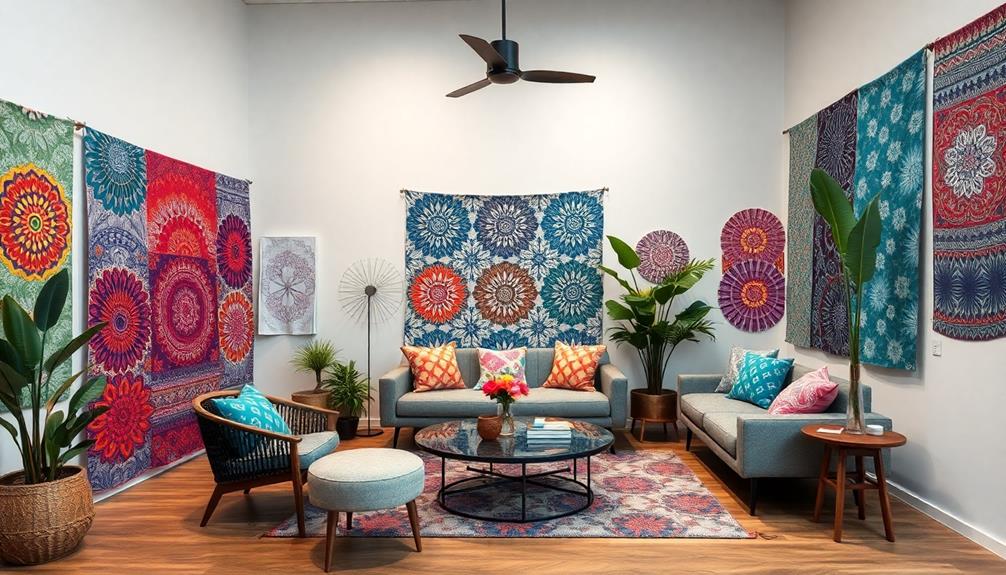
When you're exploring batik, you'll quickly notice the traditional wax-resist method at play, where hot wax creates stunning patterns on fabric.
This technique isn't only a demonstration of the cultural heritage of Indonesia but also showcases the vibrant colors and intricate patterns that enhance living spaces.
You'll also discover various color application techniques that enhance the vibrancy and depth of each piece, making them perfect for Indonesian decorative pillows.
Understanding these methods is key to appreciating the artistry behind batik patterns.
Traditional Wax-Resist Method
As you explore the traditional wax-resist method of batik, you'll discover a fascinating interplay of art and culture. This technique involves applying hot wax to fabric in intricate patterns, which allows you to create designs that are vibrant and deeply expressive.
The process typically starts with the wax application, where tools like the tjanting are essential for detailed work. You can also use stamps for quicker production, especially in the Batik Cap method. Additionally, the vibrant artistry found in Indonesian Decor Masks reflects the rich cultural heritage that complements batik designs.
The beauty of this technique lies in the careful control of temperature, ensuring the wax flows smoothly onto the fabric. Once the wax has cooled, the fabric is dyed, leaving the waxed areas untouched and undyed. This results in stunning contrasts that highlight your chosen designs.
The materials commonly used include cotton and silk, while the dyes are often derived from natural sources, offering a wide range of colors.
Additionally, the traditional wax-resist method not only showcases your artistic expression but also carries cultural significance, reflecting regional identities and community beliefs. Embracing this technique will bring a unique and timeless quality to your home decor.
Color Application Techniques
Mastering color application techniques in batik can transform your fabric into a vibrant masterpiece. Start by selecting a color palette that speaks to you, then apply dye in layers—beginning with lighter colors and gradually moving to darker shades. This technique creates depth and contrast in your patterns.
Before you plunge in, mix your dye with chemical water and conduct color tests on kitchen paper. This guarantees you achieve the desired strength before applying it to your fabric. Don't forget that multiple dye baths can enhance your designs, allowing intricate color blending and unique shades.
Proper drying time between applications is essential to maintaining crisp lines. If you're short on time, a hair dryer on a cold setting can expedite the process. Additionally, experimenting with various wax application techniques will lead to distinctive patterns and textures, greatly influencing your final piece.
Here's a quick reference table to guide you:
| Technique | Description |
|---|---|
| Layering Colors | Apply lighter shades first, then darker ones |
| Multiple Dye Baths | Use various baths for complex color blends |
| Drying Methods | Allow proper drying; use cold air if needed |
With these techniques, you're ready to create batik that reflects your style!
Types of Batik Patterns

Batik patterns offer a rich tapestry of artistic expression, each type showcasing unique techniques and cultural significance. One of the most traditional forms is Batik Tulis, which features hand-drawn designs. This labor-intensive method results in intricate and unique patterns, often commanding higher prices due to the skill involved.
In contrast, Batik Cap employs a stamped technique, allowing for quicker production and more uniform designs at a more affordable price point. Additionally, the cultural storytelling aspect of batik patterns can enhance the understanding of Indonesian heritage, making them a visually appealing choice for decor enthusiasts looking to showcase authenticity and craftsmanship in their spaces important cultural elements.
Then there's Batik Lukis, which uses painting techniques, giving modern artists the freedom to explore contemporary designs while still embracing the essence of batik. Each of these types reflects distinct regional artistry and holds cultural importance, with both Batik Tulis and Batik Cap recognized by UNESCO as Masterpieces of Intangible Heritage.
The diversity of batik patterns means you can easily find options that enhance your home decor. By incorporating various styles, you can create a cohesive look that celebrates cultural craftsmanship and adds a unique batik shine to your space.
Whether you choose traditional motifs or modern interpretations, batik patterns bring depth and character to your home.
Incorporating Batik in Decor

Integrating batik patterns into your home decor can elevate your space while celebrating rich cultural heritage. You can easily incorporate batik through various accent pieces that add a vibrant touch, like throw pillows. These not only enhance your decor but also complement different design styles, making them a perfect addition to a harmonious environment.
If you're looking for a statement piece, consider large-scale batik tapestries or wall hangings. They serve as eye-catching focal points, showcasing intricate designs and adding depth to your living spaces.
Another way to incorporate batik is through furniture upholstery. Transform ordinary dining chairs or ottomans into standout items that celebrate craftsmanship and artistry. Additionally, using batik in textiles like bed linens or table runners brings a unique cultural flair to your everyday living.
Batik's versatility allows you to blend it with other decor elements effortlessly. Pair it with modern furniture or rustic accessories to create a harmonious mix of traditional and contemporary styles.
As a design expert would suggest, these thoughtful combinations make your home feel both modern and timeless, reflecting your personal taste while honoring the beauty of batik art.
Cultural Significance of Batik

Batik patterns aren't just beautiful; they carry deep cultural significance tied to heritage and identity. Each design you see tells a story, rich with symbolism that reflects the values and traditions of the community.
This cultural artistry is reminiscent of the traditional Indonesian housing styles, where architectural features often serve as a canvas for expressing heritage and social status, as seen in traditional Indonesian housing.
Heritage and Identity
Steeped in tradition, batik weaves together threads of heritage and identity, acting as an essential link to the rich tapestry of cultural narratives. This intricate art form remains a significant connection to cultural heritage, reflecting historical stories and community beliefs through unique designs and patterns. Each piece of batik holds specific meanings, symbolizing not just cultural identity but also social status and regional affiliation within Indonesian society.
The use of natural materials and vibrant colors in batik designs echoes the aesthetics found in traditional Indonesian style home decor, enhancing its significance in modern interiors.
Batik's significance extends into important life events, often featuring prominently in ceremonies related to birth, marriage, and death. This deep-rooted connection to religious and cultural practices emphasizes how integral batik is to traditional celebrations.
Recognized by UNESCO as a Masterpiece of the Oral and Intangible Heritage of Humanity, batik plays an essential role in preserving cultural identity and fostering appreciation for traditional crafts.
Incorporating batik into your home decor not only enhances your living space but also invites a deeper understanding of its cultural context. By showcasing these patterns, you celebrate diversity and encourage cultural exchange, enriching your environment while honoring the stories woven into each fabric.
Embrace the heritage and identity that batik represents, and let it inspire your modern yet timeless home.
Symbolism in Design
Incorporating batik into your home decor opens a window to the rich symbolism woven into each design.
Each batik pattern tells a story, reflecting Indonesia's vibrant cultural identity and heritage, much like the traditional motifs and patterns used in Indonesian wedding decor.
When you choose batik, you're not just adding a beautiful element to your space; you're embracing the meanings behind the art.
Here are four significant aspects of batik symbolism in design:
- Good Luck: Many patterns are believed to bring good fortune and protection to your home.
- Social Status: Unique designs can signify various cultural identities and social standings within the community.
- Nature Connection: Intricate motifs often represent elements of nature, highlighting the relationship between art and the environment.
- Historical Narratives: Batik patterns serve as storytelling mediums, conveying community beliefs and historical events.
Modern Trends in Batik Design

Today, modern trends in batik design showcase a vibrant fusion of traditional craftsmanship and contemporary aesthetics. You'll find that contemporary batik often embraces bold color palettes and geometric patterns, making it a perfect fit for today's stylish interiors. Additionally, batik patterns in interior design have gained popularity for their ability to add a touch of cultural richness and artistic flair to modern homes. Whether used in upholstery, wall art, or accent pieces, these intricate patterns can effortlessly bridge the gap between heritage and innovation. As a result, batik has become a celebrated element in both minimalist and eclectic spaces alike.
The integration of batik into home decor has surged, with pieces like accent pillows, wall art, and upholstery taking center stage in trendy homes. Additionally, these designs can complement tropical villa plans that emphasize open spaces and natural light for a serene atmosphere.
Moreover, eco-friendly batik production practices have emerged, reflecting a growing consumer demand for sustainable textiles. This commitment to eco-friendly batik guarantees that you're not only enhancing your space but also supporting responsible production methods.
Digital printing technology has also transformed the accessibility of batik designs, allowing you to incorporate these stunning patterns into various modern design styles without sacrificing the essence of traditional techniques.
As you explore seasonal batik collections, you'll discover designs that align with current interior trends while celebrating cultural heritage. These collections resonate with diverse consumers, guaranteeing that you can find the perfect batik piece that complements your unique style.
Embrace these modern trends to create a home that's both timeless and fresh.
Frequently Asked Questions
How Are Batik Used Nowadays?
Batik's used today in various ways, from vibrant accent pillows to large tapestries. You'll find it in eco-friendly collections, merging artistry with sustainability, enhancing your space with rich colors and unique patterns that tell a story.
How to Batik at Home?
Imagine transforming plain fabric into a canvas of vibrant stories. You'll gather materials, prepare your fabric, apply wax designs, dye in layers, and finally reveal your masterpiece by boiling away the wax. It's art in motion!
What Kind of Art Is Modern Batik?
Modern batik is a vibrant art form that combines traditional wax-resist techniques with contemporary designs. You'll find it in textiles and wall art, reflecting both cultural heritage and current trends, appealing to diverse tastes.
What Common Motifs Make This Style of Batik Recognisable?
You'll recognize common batik motifs like flowers, leaves, and geometric patterns. The "Parang" represents ocean waves, while "Kawung" symbolizes life cycles. Each region offers unique designs, reflecting Indonesia's rich cultural heritage and biodiversity.
Conclusion
Incorporating batik patterns into your home decor isn't just a trend; it's like weaving a rich tapestry of culture and history into your space. By understanding batik's ancestral roots and techniques, you can create a modern yet timeless aesthetic that speaks volumes. Embrace the vibrant colors and intricate designs, and let your home tell a story that transcends generations. With batik, you're not just decorating; you're making a bold statement that celebrates artistry and heritage.
